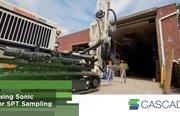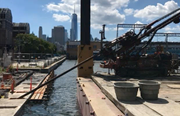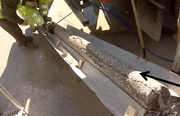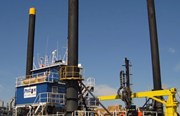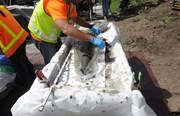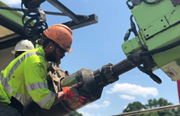In our Drilling 201 webinar, we discussed sonic drilling methodologies and best practices. Our goal was to provide a working knowledge of this highly viable drilling method to those unfamiliar with sonic drilling and its typical applications. If you missed the webinar, don’t worry! This post covers all the key points. Don't forget to sign up for our upcoming webinars in the series.
Choosing a Drilling Methodology
When choosing a drilling method, we weigh the method of penetration, cuttings removal, and boring stabilization against geological constraints and project goals. Sonic drilling is often used when drilling through challenging ground materials or to significant depths while maintaining core sample integrity.
Method vs. Platform
It’s important to distinguish between the drilling method and the rig platform. Just because a rig is considered auger or direct push doesn’t mean it's limited to that method. For example, Geoprobe™ rigs can accommodate various drilling methods. The platforms come in full size, mini, all terrain, limited access, and restricted access. One of the major benefits of sonic drilling is its versatility, as it can be used on different rigs and supports many tool types.
How Sonic Drilling Works
Sonic drilling gets its name from the mechanism driving the drill bit. Two oscillators in the sonic drill head act as counterweights. When tuned correctly, they generate resonance down the tool string to the bit, driving the drill downward.
Method of Penetration
-
Rotation and Resonance: The drill bit is driven into the ground through a combination of rotation and resonance.
Method of Removing Cuttings
-
Core Sample or Displacement: Cuttings are either recovered as a core sample or displaced to the outside of the borehole. Samples are stored in polyethylene or Lexan liners, which are also suitable for long-term storage.
Method of Stabilizing Boring
-
Core and Case: The core barrel is run into the ground, followed by overriding the casing over the core barrel before retraction. Water is sometimes used at greater depths, but dry methods are preferred to determine groundwater presence.
Method of Penetration
-
Rotation and Resonance: The drill bit is driven into the ground through a combination of rotation and resonance.
Method of Removing Cuttings
-
Core Sample or Displacement: Cuttings are either recovered as a core sample or displaced to the outside of the borehole. Samples are stored in polyethylene or Lexan liners, which are also suitable for long-term storage.
Method of Stabilizing Boring
-
Core and Case: The core barrel is run into the ground, followed by overriding the casing over the core barrel before retraction. Water is sometimes used at greater depths, but dry methods are preferred to determine groundwater presence.
Waste Minimization
Sonic drilling generates about 60-70% less waste than hollow stem auger methods.
Safety and Cleanliness
Sonic drilling is generally safer and more stable. It is also cleaner, especially with dry drilling, minimizing contamination at the surface.
No Refusal
Sonic drilling faces low to no refusal in typical applications, though it may slow down in hard rock.
Value in Total Delivered Cost
While sonic drilling may have higher upfront costs, its overall value is evident in better information, easier scheduling, single mobilization efforts, waste minimization, and improved well installations.
Typical Sonic Drilling Applications
Sonic drilling is well-suited for a variety of applications, including:
Geotechnical Investigation
Provides enhanced information, overcoming issues like poor recovery and inefficiency.
-
Typical Projects: Dams, tunnels, bridges, landslides, foundations
Sampling
Maintains integrity and quality of core samples with minimal borehole deviation.
-
Sampling Options: standard penetration test (SPT), spit-spoon, undisturbed/Shelby tubes, Dennison, in situ testing, borehole pressure meter, cone penetration testing (CPT), diamond coring
Earthen Embankments
Useful in projects where fluid or air-based drilling methods are restricted.
Remediation
Ideal for environmental remediation, enabling low mobility/compaction grouting and high-mobility grout curtains.
Instrumentation & Monitoring
Accurately installs instruments with minimal impact.
-
Instruments: Inclinometers, extensometers, VWPs, freeze pipes, open stand-pipe piezometers
Groundwater Profile
Excellent for obtaining groundwater profiles without compromising borehole integrity.
Heat Mitigation for VOC Sampling
Reduces heat to maintain sample integrity through various methods like infrared thermometers, shortened coring runs, and more.
Additional Applications
Includes wireline high-speed coring, vertical aquifer sampling (VAS) groundwater profiling, Dennison & fixed-piston sampler, pressure meter testing, bedrock packer testing, and down-the-hole (DTH) hammer drilling.
Markets Served
Sonic drilling is flexible and advantageous for various markets:
-
Environmental: Investigation, remediation, well installation
-
Geotechnical: Investigation, ground improvements, instrument installation, infrastructure
-
Mining: Exploration, tailings, dumps, leach-pad drilling
-
Water: Hydrogeological evaluations, well & piezometer installation
Conclusion
Sonic drilling uses a resonating drill string to overcome friction and drive a bit to specific depths. Its benefits include faster, cleaner, and safer operations, high-quality core and water samples, minimal borehole deviation, and suitability for difficult drilling applications. For more information or project assistance, please contact us here.
For more information on our sonic technology capabilities, download our free brochure here.



